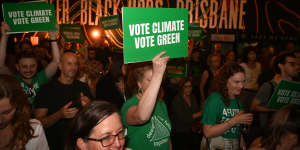In Ryan,those numbers were 14.44,18.75 and 20.35. In Brisbane,14.34,19.4 and 22.37. All young areas with,importantly,a lot of renters.
Sri says he traced the surge’s beginning to the University of Queensland’s sandstone St Lucia campus,in Brisbane’s inner-east.
“I think it starts with me and Max meeting at uni,when Max was still in the Labor Party,and him then agreeing to manage my[council] campaign,” he says.
“And then a couple of us decided that we’re going to make a concerted effort to both build the Greens up in Queensland,but also keep the Greens true to its more radical roots.
“After the 2010 victory[in which Waters was elected to the Senate],to be blunt,the party was sort of just in a holding pattern. The vote wasn’t really growing and I think there were a lot of people within the Greens who didn’t really have a broader critique of capitalism.
“Out in the general public,the Greens were really just seen as being concerned about trees and koalas.”

The Greens held their national campaign launch in Brisbane on May 16.Credit:Dan Peled/AAP
Sri says he was determined to change that as the city battled with the pressures of a growing population and soaring costs of living.
“We started talking about ideas like rent controls during The Gabba ward campaign,which at the time was seen as too extreme and left-wing,even for the Greens,” he says.
“Whereas now,rent controls have become part of the federal policy as well as the Queensland Greens policy.”
Williams says he can not fault the Greens’ effectiveness,which has certainly borne fruit in the Queensland capital.
“We all knew it was coming,that inner-Brisbane would follow inner-city Melbourne,but the growth of the Greens’ support was accelerated at a faster rate than many people,myself included,expected,” he says.
“The Greens were saying for a long time they’re going to win Griffith and I didn’t share their view this time,especially when you’re up against such a strong MP in Terri Butler.
“But they have done it and it’s down to their micro-campaign. They conducted three very good local campaigns in the three seats.”
Included in that was also a laser focus on local issues,such as this year’s devastating floods (which dovetailed nicely into the wider climate change campaign) andaircraft noise from Brisbane Airport’s new parallel runway.
“I think for some people that might sound like a trivial issue,but if you’re exposed to over 80 or 85 decibels’ worth of noise frequently at night,sometimes at 2.30am,we know from studies around the world this has a massive detrimental effect on people’s health,”Chandler-Mather said as he took his victory lap on Sunday.
On that point,Waters says:“It shows that focused grassroots campaigning,one-on-one conversations and community engagement works.”
Williams says he expects the Greens to be entrenched in the city,even if Labor manage to win the seat of Brisbane this time around.
“You wouldn’t want to be the Labor or LNP candidates in Brisbane next time,” he says.
If there is one take-out from the election,for Waters and Sri it is that Queensland’s reputation as a conservative state needs re-evaluation.
“Queenslanders value people who speak their minds and don’t bullshit them,” Waters says.
“They like big ideas and abhor small targets. The Greens got a really great reception in places like central Queensland because we told people the truth:coal and gas are on their way out and the corporations don’t care about your jobs and your communities.”
Sri says the view of Queensland as a redneck wonderland demonstrates a “really simplistic and shallow understanding” of the state’s values and psyche.
“Really,it’s not that Queenslanders aren’t inherently conservative or backwards or anything like that. It’s that Queenslanders are instinctively anti-authoritarian and anti-establishment,” he says.
Sri says his self-described “radical” approach to politics,in which heregularly urges civil disobedience and runs afoul of the council’s Conduct Review Tribunal for his activism,strikes a chord with disaffected voters.
“To be honest,I think for some voters even people like Larissa might seem a little bit more like an establishment politician,” he says.
“Certainly down south,the Greens are more easily lumped in with the political establishment,whereas up here in Queensland,it’s very obvious to anyone who cares to look that we’re definitely quite different to Labor and the Liberals.
“We’re taking them on quite directly,rather than seeking to buddy up with them.
“... Queensland is not conservative,we’re just instinctively anti-establishment. And the Queensland Greens have succeeded in positioning ourselves as an anti-establishment party,standing up to the status quo.”
Sri says his election,and the subsequent rise of a more radical Greens movement in Brisbane,was a turning point for the party nationally.
“There was an explicit project to demonstrate that a more radical political vision and policy platform could also be electorally successful,” he says.
“Winning The Gabba ward,and then Michael[Berkman] winning in 2017,helped us win the argument nationally,that the Australian Greens should also take a broader and bolder policy platform to the electorate.”

Greens state MPs Amy MacMahon (South Brisbane) and Michael Berkman (Maiwar).Credit:Matt Dennien
Williams warns caution against that approach,however.
“I think it’s fair to say Jonathan Sri is a deep Green,and I mean that in no pejorative way,” he says.
“Australia is not,even in the inner-suburbs,is not ready for a deep Green agenda. That’s why the teals are there.
“People in the affluent suburbs of Sydney and Melbourne passionately want action on climate change and for them it’s a tier one issue,but notice they voted teal,not Green.
“Economically,they’re fiscally conservative,they don’t want big government and they don’t want high taxes.
“They don’t want a socialist program,they just want integrity in politics,a better deal for women and action on climate change.”
For now,Waters says she is “overjoyed” to have more maroon in the Greens party room.
“The Greens were the only party being honest with people and providing a positive plan for how we transition to a renewable economy,” she says.
“And now we’re the biggest third party in Australian history.”